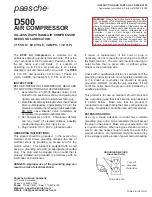
1--3
62--11052
1.4 DETAILED DESCRIPTION
1.4.1 Service Valves
The suction and discharge service valves used on the
compressor are equipped with mating flanges for
connection to flanges on the compressor. These valves
are provided with a double seat and a gauge connection,
which allows servicing of the compressor and
refrigerant lines (See Figure 1-1).
Turning the valve stem counterclockwise (all the way
out) will
backseat
the valve to open the suction or
discharge line to the compressor and close off the
gauge connection. In normal operation, the valve is
backseated to allow full flow through the valve. The
valve should always be backseated when connecting
the service manifold gauge lines to the gauge ports.
Turning the valve stem clockwise (all the way forward)
will
frontseat
the valve to close off the suction or
discharge line to isolate the compressor and open the
gauge connection.
To measure suction or discharge pressure, midseat the
valve by opening the valve clockwise about 2 turns. With
the valve stem midway between frontseated and
backseated positions, the suction or discharge line is
open to both the compressor and the gauge connection.
1.4.2 Suction And Discharge Valves
The compressor uses reed type suction and discharge
valves made of highest quality steel for long life. The
valves operate against hardened integral seats in the
valve plate.
The downstroke of the piston admits refrigerant gas
through the suction valve, and then compresses this
gas on the upstroke, thereby raising it’s temperature
and pressure. The compressed gas is prevented from
re--entering the cylinder on it’s next downstroke by the
compressor discharge valve. (See Figure 1-2)
1. Valve Spring
2. Suction Valve
3. Valve Plate
4. Discharge Valve
5. Discharge Valve
Backer
5
1 2
3
4
Figure 1-2. Suction & Discharge Valve
1.4.3 Lubrication System
Force--feed lubrication of the compressor is accomplished
by an oil pump (See Figure 1-3) driven directly from the
compressor crankshaft. Refrigeration oil is drawn from the
compressor crankcase through the oil filter screen and
pick up tube to the oil pump located in the bearing head
assembly. The crankshaft is drilled to enable the pump to
supply oil to the main bearings, connecting rod bearings,
and the shaft seal.
Figure 1-3. Oil Pump
The oil flows to the pump end main bearings, connecting
rod bearings and seal end main bearings, where the oil
path is divided into two directions. The largest quantity
flows to the oil relief valve, which regulates oil pressure
at 15 to 18 psi (1.02 to 1.22 bar) above suction pressure.
When the oil pressure reaches 15 to 18 psi (1.02 to 1.22
bar) above suction pressure, the relief valve spring is
moved forward allowing oil to return to the crankcase.
The remaining oil flows through an orifice and into the
shaft seal cavity to provide shaft seal lubrication and
cooling. This oil is then returned to the crankcase
through an overflow passage.
An additional oil pressure relief valve, built into the oil
pump. It opens at speeds above 400 rpm to relieve a
portion of the oil pressure to the crankcase in order to
maintain oil pressure below an acceptable maximum. At
low speeds, the valve is closed to ensure adequate oil
pressure at 400 rpm. At speeds above 1900 rpm, the oil
pressure will be 25 to 30 psi (1.70 to 2.04 bar) above
suction pressure.
The crankcase pressure equalization system consists of
two oil return check valves and a 1/8--inch pressure
equalization port between the suction manifold and
crankcase. Under normal conditions, check valves are
open and allow for oil return to the crankcase. Under
flooded start conditions, pressure rises in the crankcase
and closes the check valves, preventing excess oil loss.
The equalization port allows for release of excessive
pressure, that has built up in the crankcase, to the suction
manifold; this ensures that the oil loss is kept to a
minimum.
1.4.4 Shaft Seal Reservoir
1. Shaft Seal Reservoir
2. Access Valve (Coreless)
1
2
Figure 1-4. Shaft Seal Reservoir
The shaft seal oil reservoir has been fitted to the
crankcase. The coreless access valve taps into the
crankshaft seal cavity where any oil that escapes the
crankshaft seal will form. The coreless access valve
then drains that compressor oil that escapes the
crankshaft seal into the shaft seal reservoir.
Summary of Contents for 05G TWIN PORT
Page 1: ...Compressor 62 11052 Rev C WORKSHOP MANUAL for MODEL 05G TWIN PORT COMPRESSOR R...
Page 2: ......
Page 3: ...WORKSHOP MANUAL COMPRESSOR MODEL 05G TWIN PORT...
Page 4: ......
Page 14: ......
Page 26: ......
Page 28: ......
Page 29: ......
Page 30: ......
Page 31: ......












































